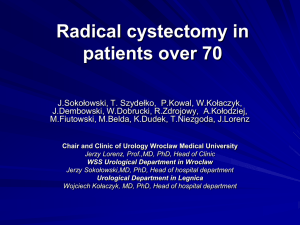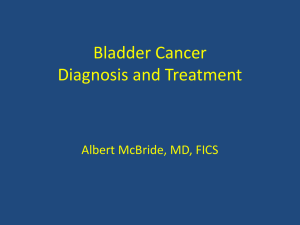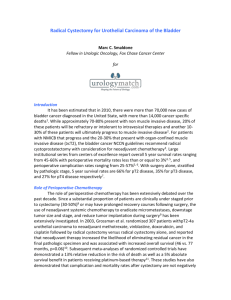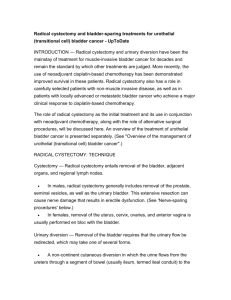Bladder Cancer
advertisement
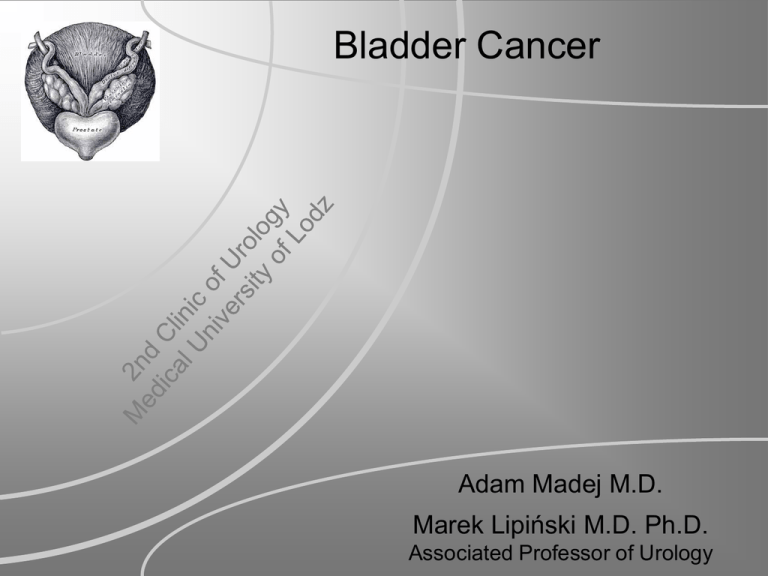
Bladder Cancer Adam Madej M.D. Marek Lipiński M.D. Ph.D. Associated Professor of Urology EBM Guidelineses Two guidelineses = Two diseases Epidemiology • fourth most common cancer in men • male-to-female 3.8 : 1 • 6.6% of the total cancers in men / 2.1% in women 2006, Europe: 104,400 incident cases of bladder cancer 82,800 in men 21,600 in women Epidemiology Initial diagnosis of bladder cancer: 70% non-muscle-invasive 30% muscle-invasive Risk factors Tobacco smoking !!! the most well-established risk factor causing about 50-65% of male cases and 20-30% of female cases related to the duration of smoking and number of cigarettes smoked per day Occupational exposure to chemicals work-related cases = 20-25% benzene derivatives and arylamines Professions who use rubbers, textiles, paints, leathers and chemicals Phenacetin Risk factors EBRT external beam radiation therapy for gynaecological malignancies Dietary factors hypothesis; vegetable and fruit intake reduced the risk of bladder cancer Chronic urinary tract infection invasive squamous cell carcinoma schistosomiasis Cyclophosphamide Gender Classification 2002 TNM by UICC (Union International Contre le Cancer) Classification 2002 TNM by UICC (Union International Contre le Cancer) NMIBC Histological grading PUNLMP The PUNLMP are defined as lesions that do not have cytological features of malignancy but show normal urothelial cells in a papillary configuration. Although they have a negligible risk for progression, they are not completely benign and still have a tendency to recur. Morphological subtypes Muscle-invasive bladder cancer In this stage all cases are high-grade urothelial carcinomas (grade II or grade III in WHO 1973), but some morphological subtypes can be most important for prognosis and treatment decisions: • Small-cell carcinomas • Urothelial carcinomas with squamous and/or glandular partial differentiation • Spindle cell carcinomas • Some urothelial carcinomas with trophoblastic differentiation Diagnosis Symptoms • Painless haematuria !!! • urgency • dysuria • increased frequency • pelvic pain in more advanced tumours Diagnosis Physical examination • rectal and vaginal bimanual palpation A palpable pelvic mass can be found in patients with locally advanced tumours. In addition, bimanual examination should be carried out before and after TUR to assess whether there is a palpable mass or the tumour fixed to the pelvic wall. Diagnosis Imaging • IVU intravenous urography • CT computed tomography • US ultrasonography • CT urography Diagnosis Imaging • IVU intravenous urography • CT computed tomography • US ultrasonography • CT urography Diagnosis Imaging • IVU intravenous urography • CT computed tomography • US ultrasonography • CT urography Diagnosis Imaging • IVU intravenous urography • CT computed tomography • US ultrasonography • CT urography Diagnosis Urinary cytology Examination of a voided urine or bladder-washing specimen >>> exfoliated cancer cells high sensitivity in high-grade tumours Diagnosis Cystoscopy The diagnosis of bladder cancer depends on cystoscopic examination of the bladder and histological evaluation of the resected tissue. Diagnosis Transurethral resection (TUR) The goal of TUR is to make the correct diagnosis, which means including bladder muscle in the resection biopsies. Diagnosis Transurethral resection (TUR) Small tumours (less than 1 cm) resection en bloc the specimen contains the complete tumour plus a part of the underlying bladder wall including bladder muscle Larger tumours resection in fractions • exophytic part of the tumour • underlying bladder wall with the detrusor muscle • edges of the resection area Diagnosis Transurethral resection (TUR) As a standard procedure, cystoscopy and TUR are performed using white light. However, the use of white light may lead to missing lesions that are present but not visible. Flat urothelial lesions such as dysplasia or carcinoma in situ are difficult to be identified under routine cystoscopic procedures. Small papillary tumors can be easily overlooked during conventional white light cystoscopy. Photodynamic diagnosis Photodynamic diagnisis (PDD) involves fluorescence to localise abnormal tissue. This method is based on selective accumulation of fluorochrome (hexaminolevulinate; 5-ALA) in malignant cells. FLUOROCHROME hexaminolevulinate 5-ALA >>> PROTOPORPHYRIN IX Optical filter (405 nm) Photodynamic diagnosis white light cystoscopy fluorescence-guided cystoscopy Diagnosis Bladder and prostatic urethral biopsy The biopsies from normal-looking mucosa in patients with bladder tumours so called random biopsies (R-biopsies) or selected site mucosal biopsies are only recommended if fluorescent areas are seen with photodynamic diagnosis (PDD). Cold cup biopsies from normal-looking mucosa should be performed when cytology is positive, when exophytic tumour is of non-papillary appearance, or when fluorescent areasare seen with PDD. Diagnosis Second resection • • when the initial resection has been incomplete • when multiple and/or large tumours are present when the pathologist has reported that the specimen contained no muscle tissue • when a high-grade, non-muscle-invasive tumour or a T1 tumour has been detected at the initial TUR Diagnosis Imaging for staging in verified bladder tumours Imaging is indicated only if there is a clinical consequence. The purpose of imaging for staging invasive bladder cancer is to: • Assess the extent of local tumour invasion • Detect tumour spread to lymph nodes • Detect tumour spread to other distant organs (liver, lung, bones, peritoneum, pleura, kidney, adrenal gland and others) Methods: CT, MR, MDCT (multidetector-row CT) Prognostic factors for NMIBC The classic way to categorize patients with TaT1 tumours is to divide them into risk groups based on prognostic factors. The scoring system is based on the six most significant clinical and pathological factors: • number of tumours • tumour size • prior recurrence rate • T category • presence of concomitant CIS • tumour grade Prognostic factors for NMIBC Weighting used to calculate recurrence and progression scores Prognostic factors for NMIBC Probability of recurrence and progression according to total score Treatment Treatment of NMIBC Treatment Transurethral resection of bladder tumor (TURBT) is the first-line treatment to diagnose, to stage, and to treat visible tumors. Patients with bulky, high-grade, or multifocal tumors should undergo a second procedure to ensure complete resection and accurate staging. Approximately 50% of stage T1 tumors are upgraded to muscle-invasive disease. Electrocautery or laser fulguration of the bladder tumor is sufficient for low-grade, small-volume, papillary tumors. Treatment Radical cystectomy in NMIBC High-grade T1 tumors that recur despite BCG have a 50% likelihood of progressing to muscle-invasive disease. Cystectomy performed prior to progression yields a 90% 5-year survival rate. The 5-year survival rate drops to 50-60% in muscle-invasive disease. Patients with unresectable large superficial tumors, prostatic urethra involvement, and BCG failure should also undergo radical cystectomy. Treatment Intravesical BCG immunotherapy (Bacillus Calmette-Guérin immunotherapy) BCG immunotherapy is used in the treatment of Ta, T1, and CIS urothelial carcinoma of the bladder • decrease the rate of recurrence and progression • it is the most effective intravesical therapy Mechanism: Immune response against BCG surface antigens cross-reacted with putative bladder tumor antigens Typically, BCG is administered weekly for 6 weeks. Another 6-week course may be administered if a repeat cystoscopy reveals tumor persistence or recurrence. Treatment Intravesical chemotherapy Valrubicin has recently been approved as intravesical chemotherapy for CIS that is refractory to BCG. Other forms of adjuvant intravesical chemotherapy for bladder cancer include intravesical triethylenethiophosphoramide (thiotepa [Thioplex]), mitomycin-C, doxorubicin, and epirubicin. Although these agents may increase the time to disease recurrence, no evidence indicates that these therapies prevent disease progression. No evidence suggests that these adjuvant therapies are as effective as BCG. Treatment Treatment of muscle-invasive and metastatic bladder cancer Treatment The standard treatment for patients with muscle-invasive bladder cancer is radical cystectomy. However, this ‘gold standard’ only provides 5-year survival in about 50% of patients. In order to improve these unsatisfactory results, the use of peri-operative chemotherapy has been explored since the 1980s. Neoadjuvant chemotherapy Neoadjuvant cisplatin-containing combination chemotherapy improves overall survival by 5-7% Neoadjuvant chemotherapy has its limitations regarding patient selection, current development of surgical technique, and current chemotherapy combinations. Neoadjuvant cisplatin-containing combination chemotherapy should be considered in muscleinvasive bladder cancer, irrespective of definitive treatment Neoadjuvant chemotherapy is not recommended in patients with PS > 2 and impaired renal function ECOG / WHO / Zubrod score ECGO score quantify cancer patients' general well-being 0 - Asymptomatic (Fully active, able to carry on all predisease activities without restriction) 1 - Symptomatic but completely ambulatory (Restricted in physically strenuous activity but ambulatory and able to carry out work of a light or sedentary nature. For example, light housework, office work) 2 - Symptomatic, <50% in bed during the day (Ambulatory and capable of all self care but unable to carry out any work activities. Up and about more than 50% of waking hours) 3 - Symptomatic, >50% in bed, but not bedbound (Capable of only limited self-care, confined to bed or chair 50% or more of waking hours) 4 - Bedbound (Completely disabled. Cannot carry on any self-care. Totally confined to bed or chair) 5 - Death Radical cystectomy Indications Traditionally radical cystectomy is recommended for patients with muscle-invasive bladder cancer T2-T4a, N0-Nx, M0 Other indications include high-risk and recurrent superficial tumours: • BCG-resistant Tis, • T1G3 • extensive papillary disease that cannot be controlled with TUR and intravesical therapy alone Radical cystectomy Indications Salvage cystectomy is indicated for: • • non-responders to conservative therapy recurrences after bladder sparing treatments • non-urothelial carcinomas • and as a purely palliative intervention for e.g. fistula formation, pain or recurrent macrohematuria Radical cystectomy Technique Radical cystectomy includes the removal of the bladder prostate seminal vesicles uterus adnexa lymphadenectomy (removal of the obturator, internal, external, common iliac, presacral nodes and nodes at the aortic bifurcation) The inclusion of the entire prostate in male patients, and the extent of urethrectomy and vaginal resection in female patients, has recently been questioned. Radical cystectomy Laparoscopic cystectomy Laparoscopic cystectomy has been shown to be feasible both in male and female patients. The cystectomy itself and the subsequent urinary diversion can be done hand-assisted, robot-assisted or unaided. Urinary Diversion From an anatomical standpoint three alternatives are presently used after cystectomy: • abdominal diversion such as ureterocutaneostomy, ileal or colonic conduit, and various forms of acutaneous continent pouch • urethral diversion which includes various forms of gastrointestinal pouches attached to the urethra as a continent, orthotopic urinary diversion (neobladder, orthotopic bladder substitution) • rectosigmoid diversions, such as uretero(ileo-)rectostomy. Urinary Diversion Ureterocutaneostomy Urinary Diversion Ileal conduit Continent cutaneous urinary diversion Colon conduit Urinary Diversion Ureterocolonic diversion Orthotopic neobladder VESICA ILEALE PADOVANA (VIP) Urinary Diversion Radical cystectomy Treatment Treatment of non-rescetable tumors Treatment Primary radical cystectomy in T4b bladder cancer is not a curative option. If there are symptoms, radical cystectomy may be a therapeutic/palliative option. The indication for performing a palliative cystectomy is symptom relief (pain, recurrent bleeding, urgency and fistula formation). Intestinal or non-intestinal forms of urinary diversion can be used with or without palliativecystectomy. Bladder Cancer Thank you



